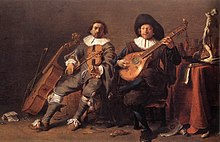Chordophone


A chordophone is a musical instrument that makes sound by way of a vibrating string or strings stretched between two points. It is one of the four main divisions of instruments in the original Hornbostel-Sachs scheme of musical instrument classification.
Hornbostel-Sachs divides chordophones into two main groups: instruments without a resonator as an integral part of the instrument (which have the classification number 31, also known as simple); and instruments with such a resonator (which have the classification number 32, also known as composite). Most western instruments fall into the second group, but the piano and harpsichord fall into the first. Hornbostel and Sachs' criterion for determining which sub-group an instrument falls into is that if the resonator can be removed without destroying the instrument, then it is classified as 31. The idea that the piano's casing, which acts as a resonator, could be removed without destroying the instrument, may seem odd, but if the action and strings of the piano were taken out of its box, it could still be played. This is not true of the violin, because the string passes over a bridge located on the resonator box, so removing the resonator would mean the strings had no tension.
Curt Sachs also broke chordophones into four basic categories, "zithers, lutes, lyres and harps."[1]
- Zithers include stick zithers such as the musical bow, tube zithers with a tube as the resonator such as the valiha, board zithers including clavichord and piano and dulcimer, and long zithers (described as combination of half-tube and board zithers) including Se and Guzheng families.
- Lutes are stringed musical instruments that include a body and "a neck which serves both as a handle and as a means of stretching the strings beyond the body."[2] The lute family includes not only short-necked plucked lutes such as the lute, oud, pipa, guitar, citole, gittern, mandore, rubab, and gambus and long-necked plucked lutes such as the tanbura, bağlama, bouzouki, veena, theorbo, archlute, pandura, sitar, setar, but also bowed instruments such as the Yaylı tambur, rebab, erhu, and entire family of viols and violins.[2]
- The Lyre has two arms, which have a "yoke" or crossbar connecting them, and strings between the crossbar and the soundboard.[1] Sachs divided this into the box lyre such as the Greek kithara and the bowl lyre which used a bowl on its side with skin soundboard.[1]
- The harp which has strings vertical to the soundboard.[1]
What many would call string instruments are classified as chordophones. Violins, guitars, lyres, and harps are examples. However, the word also embraces instruments that many would hesitate to call string instruments, such as the musical bow and the piano (which, although sometimes called a string instrument, is also called a keyboard instrument and a percussion instrument).
Electric string instruments often have an electromagnetic pickup that produces a signal that can be amplified. The electric guitar is the most common example, but many other chordophones use pickups—including mandolins, violins, and the overtone koto.
How chordophones work
When a chordophone is played, the strings vibrate and interact with each other. There is usually something that makes the sound resonate, such as the body of a guitar or violin. The strings are set into motion by either plucking (like a harp), strumming (like a guitar), by rubbing with a bow (like a violin, cello or double bass), or by striking (like a piano or berimbau). Common chordophones are the banjo, cello, double bass, dulcimer, guitar, harp, lute, piano, sitar, ukulele, viola and violin.
Origins and development
A 3,300-year-old stone carving of a Hittite bard playing a stringed instrument is the oldest iconographic representation of a chordophone and clay plaques from Babylonia show people playing an instrument that has a strong resemblance to the guitar, indicating a possible Babylonian origin for the guitar.
List of chordophones
- Banjo
- Cello
- Citole
- Clavichord
- Claviharp
- Clavinet
- Crwth
- Cuban tres
- Double bass
- Gittern
- Guitar
- Dulcimer
- Harp
- Harpsichord
- Hurdy-gurdy
- Lyre
- Lute
- Monochord
- Piano
- Psaltery
- Rebec
- Rote
- Sitar
- String drum
- Ukulele
- Veena
- Vielle
- Viol
- Viola
- Violin
See also
- History of Lute-family instruments
- K'ni, Vietnam
- Bro, Vietnam
- Kafir harp
- Kanklės, Lithuania
- Koto, Japan
- Guzheng, China
- Yatga, Mongolia
- Đàn tranh, Vietnam
- Gayageum, Korea
References
- ^ a b c d Sachs, Curt (1940). The History of Musical Instruments. New York: W. W. Norton & Company. pp. 463–467.
- ^ a b Sachs, Curt (1940). The History of Musical Instruments. New York: W. W. Norton & Company. p. 464.
